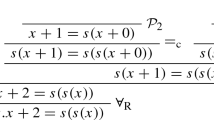Abstract
A semantic restriction is presented for use with paramodulation in automated theorem-proving programs. The method applies to first-order formulas with equality whole clause forms are Horn sets. In this method, an interpretation is given to the program along with the set of clauses to be refuted. The intention is to have the interpretation serve as an example to guide the search for a refutation. The semantic restriction was incorporated into an existing automated theorem-proving program, and a number of experiments were conducted on theorems in abstract algebra. Semantic paramodulation is an extension of set-of-support paramodulation. A comparison of the two strategies was used as the basis for experimentation. The semantic searches performed markedly better than the corresponding set-of-support searches in many of the comparisons. The semantic restriction seems to make the program less sensitive to the choice of rewrite rules and supported clauses.
Similar content being viewed by others
References
Brand, D., ‘Resolution and equality in theorem proving’, Technical Report 58, Dept. of Computer Science, University of Toronto (1973).
Brown, T., correspondence with L. Henschen (1981).
Chang, C. and Lee, R. C., Symbolic Logic and Mechanical Theorem Proving, Academic Press, New York (1973).
Digricoli, V., ‘Resolution by unification and equality’, Ph.D. thesis, New York University (1983).
Henschen, L., ‘Semantic resolution for Horn sets’, IEEE Transactions on Computers C-25(8), 816–822 (1976).
Knuth, D., and Bendix, P., ‘Simple word problems in universal algebras’, Computational Problems in Abstract Algebra (ed. J.Leech) Pergamon Press, New York, pp. 263–297 (1970).
Li da Fa, correspondence with L. Henschen (1982).
Luckham, D., ‘Some tree-paring strategies for theorem proving’, Machine Intelligence, vol. 1, Edinburgh University Press, pp. 95–112 (1969).
Lusk, E., McCune, W., and Overbeek, R., ‘Logic machine architecture’, Proceedings of the 6th Conference of Automated Deduction, Springer-Verlag Lecture Notes in Computer Science, vol. 138, pp. 70–108 (1982).
McCharen, J., Overbeek, R, and Wos, L., ‘Problems for and with automated theorem-proving programs’, IEEE Transactions on Computers C-25(8), 773–782 (1976).
McCune, W., ‘Semantic paramodulation for Horn sets’, Ph.D. thesis, Northwestern University (1984).
McCune, W., ‘User guide for the Northwestern University Theorem-proving System (NUTS)’ (1982).
Morris, J. ‘E-resolution: an extension of resolution to include the equality relation’, Proceedings of the International Joint Conference on Artificial Intelligence (1969).
Overbeek, R., McCharen, J. and Wos, L., ‘Complexity and related enhancements for automated theorem proving’, Computers and Mathematics with Applications 2, 1–16 (1976).
Sandford, D., ‘Using sophisticated models in resolution theorem proving’, Springer-Verlag Lecture Notes in Computer Science, vol. 90 (1980).
Slagle, J., ‘Automated theorem proving with semantic and renamable resolution’, J. ACM 14(1), 687–697 (1967).
Stickle, M., ‘Major success for the Knuth-Bendix procedure’, Association for Automated Reasoning Newsletter No. 2, Argonne, IL (1983).
Veroff, R., ‘Canonicalization and demodulation in theorem proving’, technical report, Argonne National Laboratory (1981).
Winker, S., ‘Generation and verification of finite models and counterexamples using an automated theorem prover answering two open questions’, J. ACM 29(2), 273–284 (1982).
Wos, L. and Robinson, G. ‘Paramodulation and theorem proving in first order theories with equality’, Machine Intelligence 4, 135–150 (1969).
Wos, L., Robinson, G., and Shalla, L., ‘The concept of demodulation in theorem-proving’, J.ACM 14(4), 698–709 (1967).
Wos, L., communication (1982).
Wos, L., and Robinson, G., ‘Efficiency and completeness of the set of support strategy in theorem proving’, J.ACM 12(4), 536–541 (1965).
Wos, L., Overbeek R., and Henschen, L., ‘Hyperparamodulation: A refinement of paramodulation’, Proceedings of the 5th Conference on Automated Deduction, Springer-Verlag Lecture Notes in Computer Science, (eds. R. Kowalski and W. Bibel), vol. 90 (1980).
Wos, L., Veroff, R., Smith, B., and McCune, W., ‘The linked inference Principle II: The user's viewpoint’, Proceedings of the 7th Conference on Automated Deduction, Springer-Verlag Lecture Notes in Computer Science, (ed. R. Shostak), Vol 170, pp. 316–332 (1984).
Author information
Authors and Affiliations
Rights and permissions
About this article
Cite this article
McCune, W., Henschen, L. Experiments with semantic paramodulation. J Autom Reasoning 1, 231–261 (1985). https://doi.org/10.1007/BF00244271
Received:
Issue Date:
DOI: https://doi.org/10.1007/BF00244271




